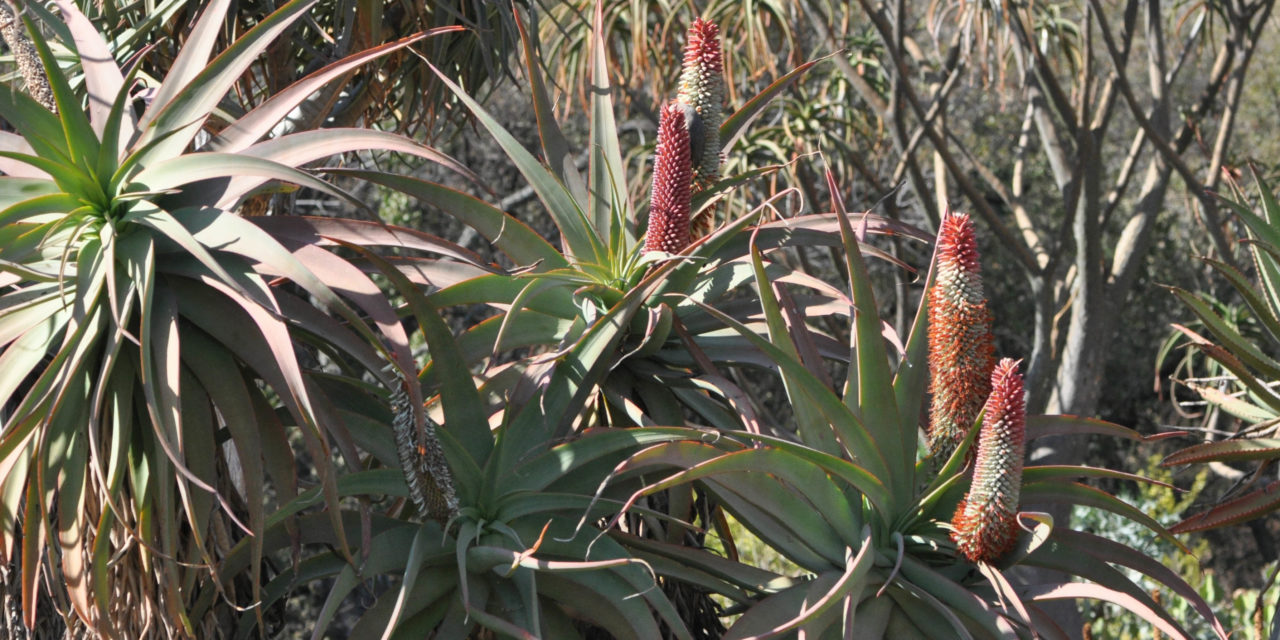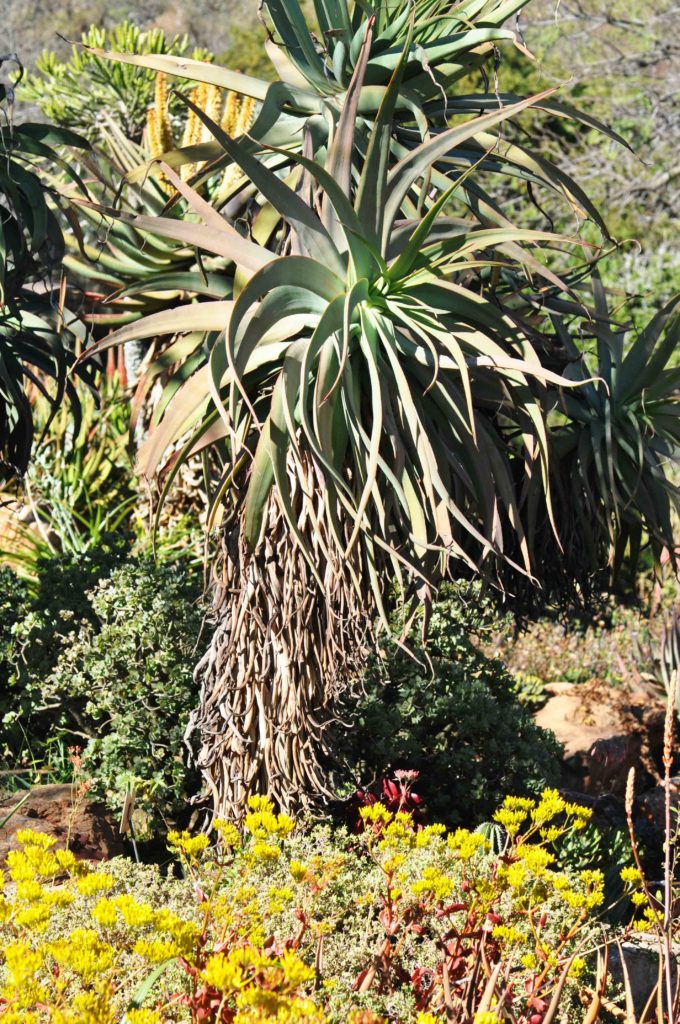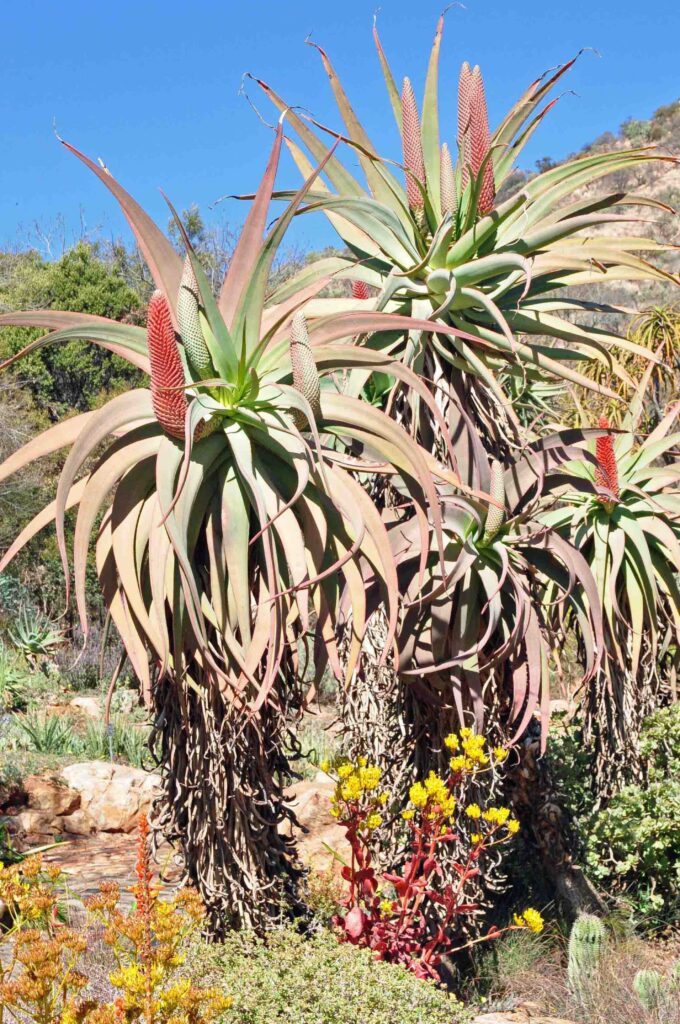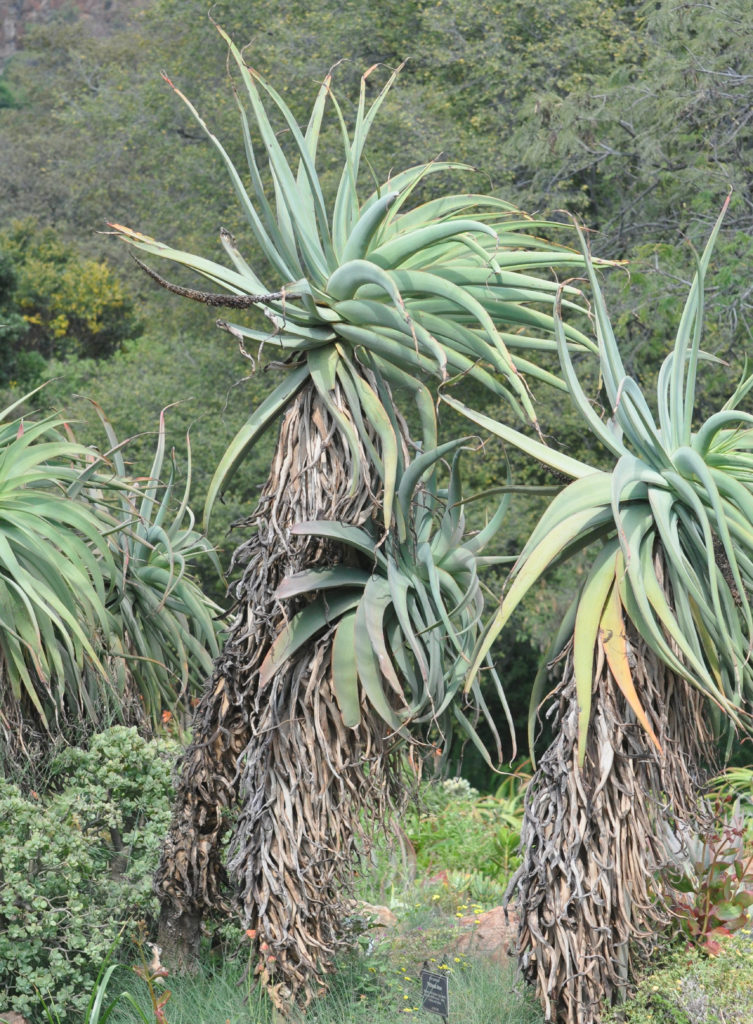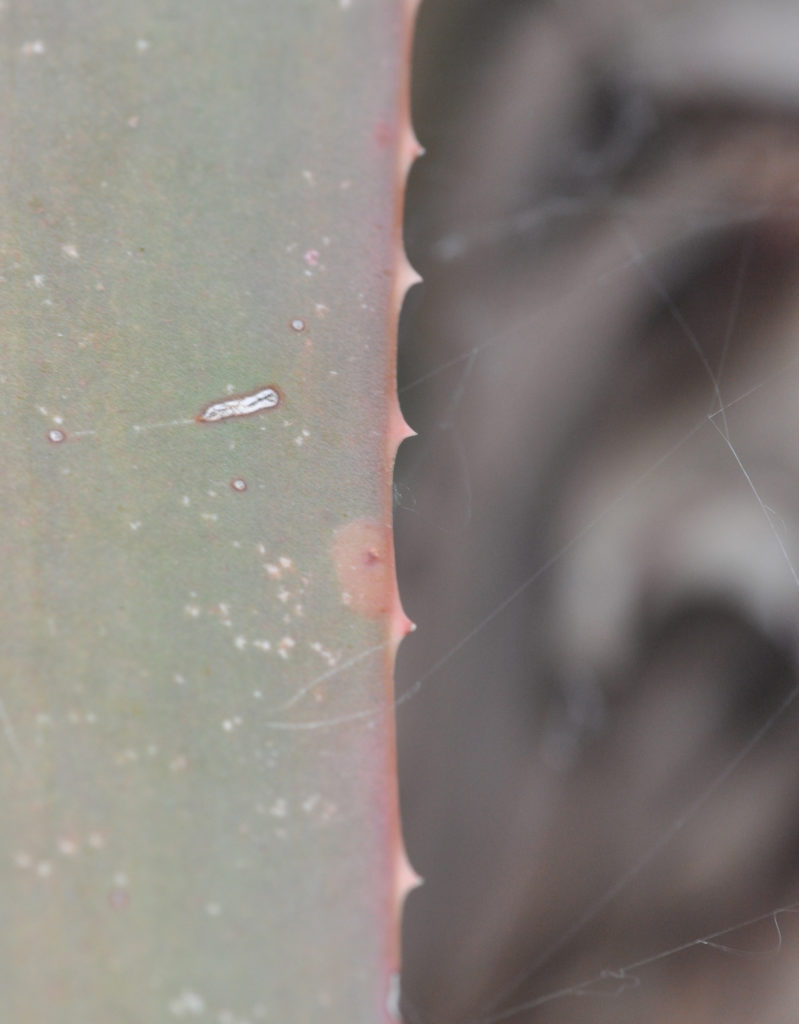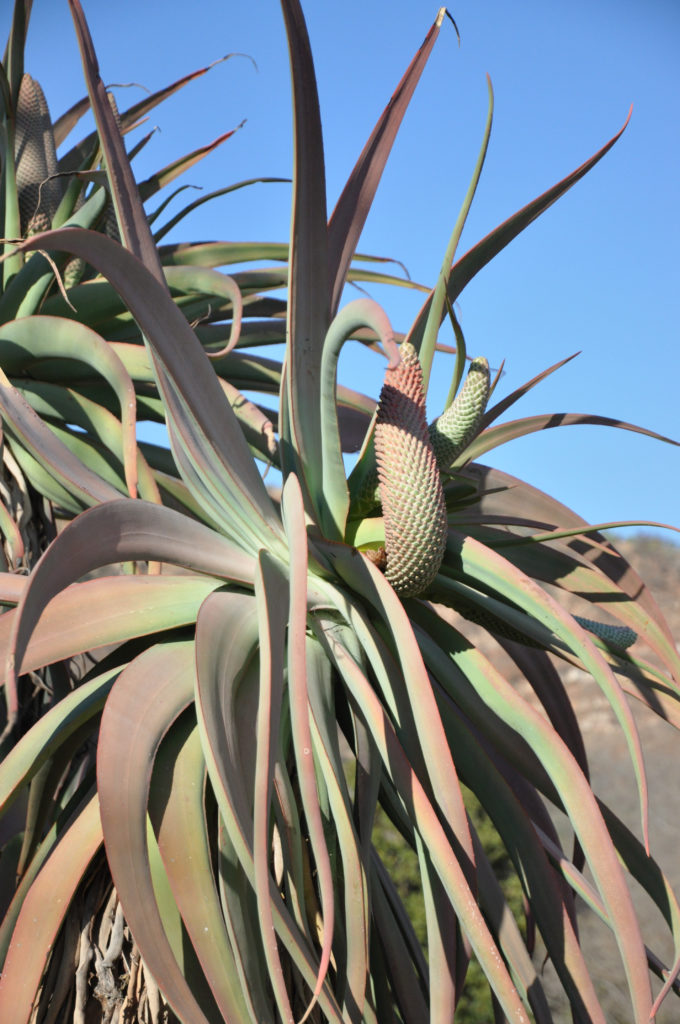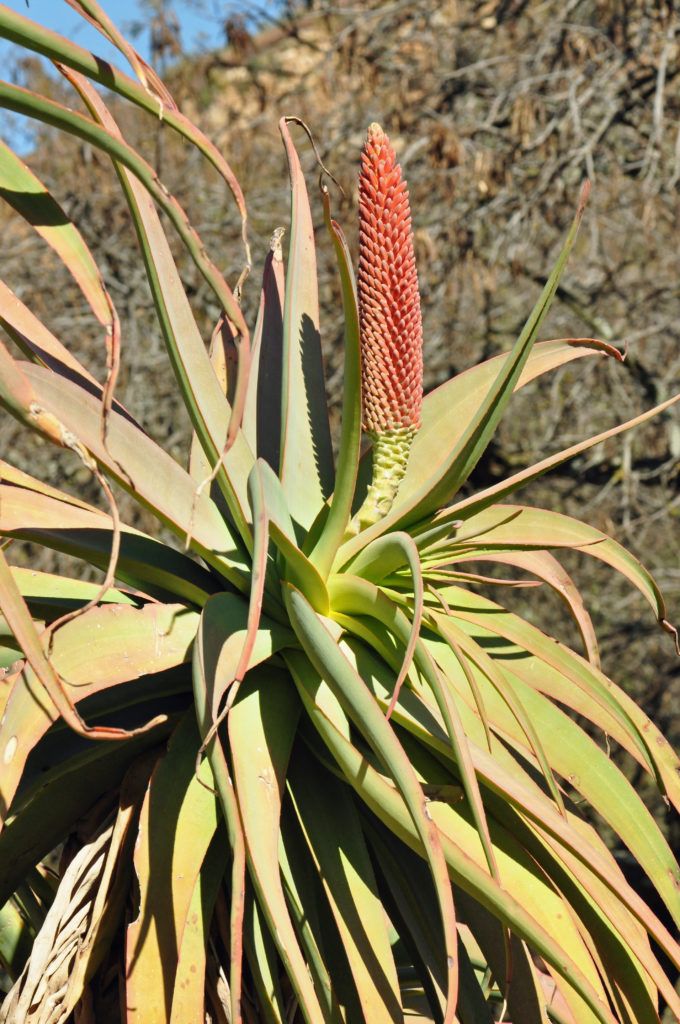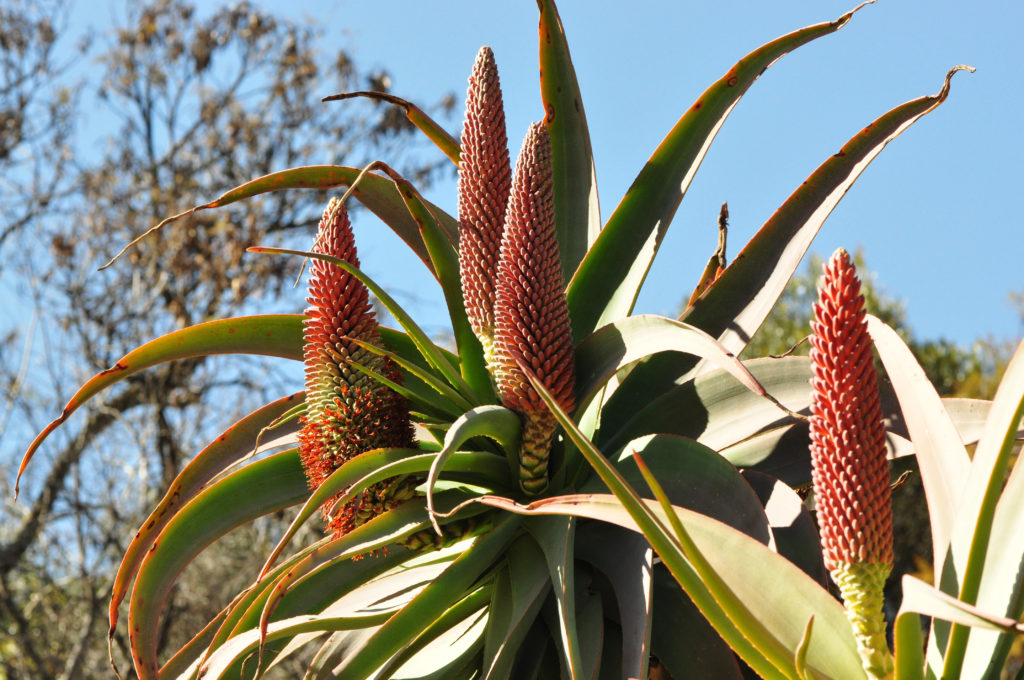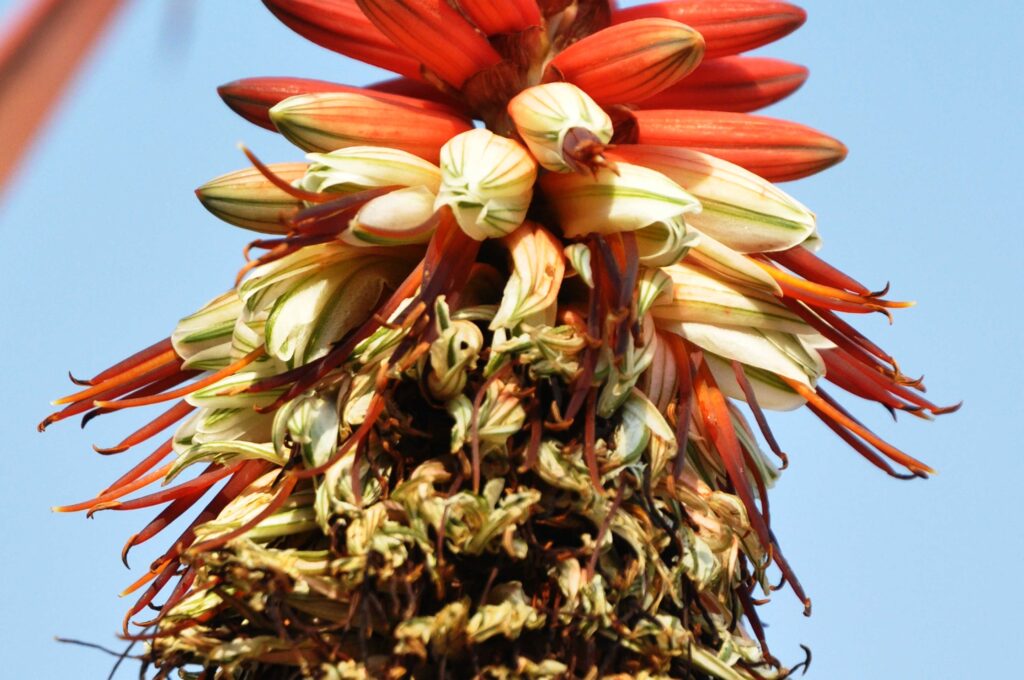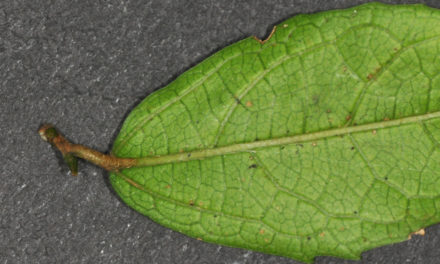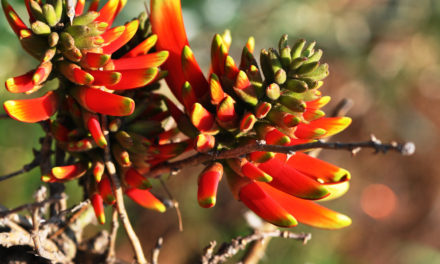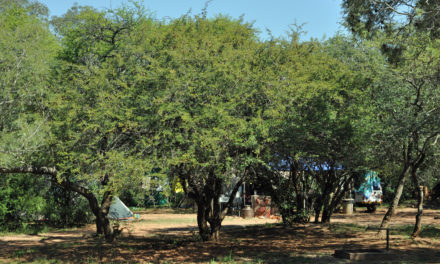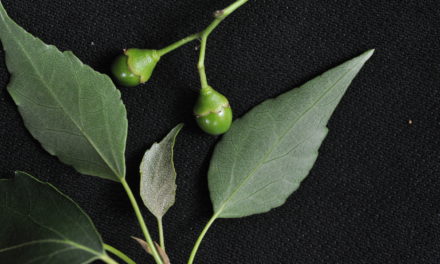Aloe speciosa
General Info – summary
This Tree is up to 6m high with some tilted leaf rosettes. Succulent amplexicaul long, thin Leaves have small pale red marginal sides. Red Flower buds are in thick racemes. Regular cylindrical bisexual 3-merous flowers are in up to 4 broad cylindrical racemes in each rosette. The now white tepals have green lines running through them. Fruit is 3-segmented, winged capsule with laterally compressed seeds.
Description
Previous Names: Aloe hexapetala.
SA Tree No. 30.5.
Common names: (Afr) Slaphoring-aalwyn, Slaphoringaalwyn, Slapoor-aalwyn, Slapoor, Spaansaalwyn, Spaans-aalwyn, Spaansalwee, Spanalwee, Spanarei-alwee, Spanareialwyn, Spanareaalwyn. (Eng) Gazaland Aloe, Tilt-head Aloe. (isiXhosa) Ikhala.
Family Asphodelaceae (Aloe Family). Presumably derived from Asphodel Meadows, which is a section of the Ancient Greek underworld where indifferent and ordinary souls were sent to live after death. The family has about 40 genera and 900 species. There are 10 genera in South Africa. This is a small but wide-spread, mainly African family of perennial plants. All have Anthraquinones (an aromatic, organic compound, which are the main active constituents of herbs – often used to relieve constipation and may possess antifungal and antiviral activities. They are also widely used in dyes). When present, the Stems are fibrous and woody. The fleshy Leaves often have spines either on the margins or on the blades. The outer 2 flower whorls (the Perianth) lack the classic distinction between calyx and corolla and the lobes are called Tepals. These 2 whorls each have 3 tepals. Flowers are usually borne on a leafless stalk arising from the rosette of leaves. Individual flowers are regular. The 6 Stamens are inserted in 2 whorls of 3, below the superior 3 locular Ovary. Fruit is usually a dry Capsule. Genera with trees on this website include Aloe, Aloidendron and Kumara.
The name Aloidendron or ‘tree aloe’ dates to 2013 and is thanks to molecular studies that are rather shaking up phylogenies and thus classifications. The rambling aloes have also been put in their own genus: Aloiampelos.
Name derivation: Aloe – dried juice from aloe leaves (Greek origin). speciosa – showy/beautiful: referring to the flowers. There are about 500 species within the Aloe genus and at least 150 indigenous in South Africa.
Conservation: National Status: L C. (Least Concern). Assessed: 2018/10/23 (H. Mtshali).
Tree
This succulent perennial Tree is usually an upright and single stemmed. However, the stem may be branched. If so, both the Branches and Stem (photo 81) are bearded with old dry shrunken leaves. This aloe is usually up to 4m high but may reach 6m in dense vegetation. These old leaves hang down at least part of the way to the ground (photos 493 & 81). Roots are succulent and terete (circular in cross-section).
- 81. 2014/06/03. Walter Sisulu NBG. Photo: David Becking.
- 493. 2015/07/28. Walter Sisulu NBG. Photo: David Becking.
Leaves
This evergreen tree has rather disorderly succulent Leaves that are long, slender and curved. The leaves form a dense spiralled rosette. Dull bluish-green leaves may be tinged with red on the upper side (photo 493 under Tree). The thin reddish leaf Margin may have small, pale reddish and dentate (with sharp, spreading, teeth). These teeth run perpendicular to the margin (photo 703). The Apex may end in a drip-tip (photo 775). The Base is amplexicaul (a leaf base that embraces and surrounds a stem). Each leaf is up to 70 x 9cm and collectively the leaves form a Rosette (a leaf arrangement radiating, in this instance, from a crown – photo 775). In this plant the rosette may be tilted to one side – often towards the sun, where the light is greatest. In South Africa when trees grow in the open, in this tilting is usually northwards. This is a distinguishing characteristic (photo 775). In this photo, the old dry shrivelled and grey leaves remain on the tree, giving a bearded appearance.
- 775M. 2015/04/21. Walter Sisulu NBG. Photo: David Becking.
- 703. 2017/09/06. Walter Sisulu NBG. Photo: David Becking.
Flowers
The collectively attractive cylindrical and deep red Flowers are arranged in broad unbranched Racemes (simple elongated inflorescence with stalked flowers that open in succession towards the apex). Up to 4 thick racemes emerge from a single rosette of leaves (photo 446). They may initially move sideways but soon bend and become vertically arranged (photo 307 & 447). Each raceme is up to 30 x 12cm and tapers slightly towards its apex (photo 446). The Peduncle (stalk supporting a cluster of flowers) is up to 12cm long (photo 447). It contains papery bracts (photo 446). The two outer whorls of each flower are referred to as Tepals (the parts of the perianth when these parts cannot easily be divided into calyx and corolla). Whereas the Buds are red (photo 447), the opening flowers are white with green lines running lengthwise (photo 1183). As they mature, the flowers point slightly downwards. This allows pollinating insects – like bees to enter, and more importantly, to exit the flowers with ease (photo 1183). In this photo the distinct brownish-orange Stamens (6) are visible. These exserted (sticking out, projecting beyond) stamens have reddish, straight Filaments (photo 1183) and darker, orange Anthers. Collectively these colours make a notable sight. There is a single Pistil (a unit of the Gynoecium, the female element of the flower, composed of the Ovary, Style and Stigma) present, and the trilocular superior Ovary has several ovules in each of its 3 locules. Each flower has a single, exserted, red Style (photo 1183), which may extends the small lighter Stigma slightly beyond the anthers of each flower. (Jul-Sep).
- 307. 2015/07/21. Walter Sisulu NBG. Photo: David Becking.
- 447. 2018/07/25. Walter Sisulu NBG. Photo: David Becking.
- 446. 2018/07/25. Walter Sisulu NBG. Photo: David Becking.
- 1183. 2018/08/18. Walter Sisulu NBG. Photo: David Becking.
Fruit
The Fruit is a 3 segmented Capsule (a dry fruit resulting from the maturing of a compound ovary which usually opens at maturity by one or more lines of dehiscence). The irregularly winged Seeds are laterally compressed.
Distribution & Ecology
Aloe speciosa is only light frost tolerant and is Endemic (Endemism is the ecological state of a species being unique to a defined geographic location) in the Western and Eastern Cape of South Africa. Rainfall, here is between 370-630mm per year. The plant is located on bushy mountains and hill-slopes, rocky outcrops including valleys and hilltops, where the surrounds are hot and dry – e.g. close to the Cango Caves (near Oudtshoorn the – the World Ostrich capital). They also occur near Pearson, Swellendam, and Kirkwood. This Aloe is common near Alicedale and Grahamstown and up to the Kei River in the Eastern Cape. Associated plants include Euphorbia species and fynbos. Other tree species that may occur with it are Pappea capensis and Euclea undulata. The relatively high quantity of nectar attracts birds, including sunbirds. These birds are important pollinating agents. They also use spider webs from the aloes as a sticky binding agent for their own nests. This aloe was initially collected near Somerset East. Natural hybrid species do occur.
Ethnobotany
The Flowers produce much nectar which attract Insects (including bees, butterflies), and Birds (Jul-Sep). Juice from the leaves can be used as a self-setting, pale red material dye. This plant does well in warm, dry areas. Plant in a warm, sunny and well-drained spot. Initial watering is important, and the addition of bonemeal will help.
References
Boon, R. 2010. Pooley’s Trees of eastern South Africa. Flora and Fauna Publications Trust, Durban.
Coates Palgrave, M. 2002. Keith Coates Palgrave Trees of Southern Africa, edn 3. Struik, Cape Town.
Lawrence, G. H. M, 1951. Taxonomy of Vascular Plants. The Macmillan Company, New York. Tenth Printing 1965.
Mtshali, H. 2018. Aloe speciosa Baker. National Assessment: Red List of South African Plants version . Accessed on 2025/03/03.
Palmer, E. & Pitman, N. 1972. Trees of southern Africa. Balkema, Amsterdam, Cape Town.
http://www.plantzafrica.com/plantab/aloespec.htm
https://en.wikipedia.org/wiki/Aloe_speciosa
http://posa.sanbi.org/flora/browse.php?src=SP

